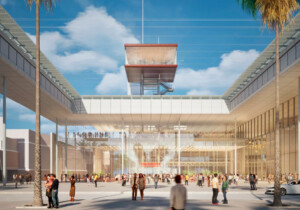Earlier today, Prime Minister Giuseppe Conte of Italy inaugurated the Renzo Piano–designed Viadotto Genova-San Giorgio (Saint George Bridge), a 3,500-foot-long concrete and steel viaduct carrying four lanes of the A10 motorway across the Polcevera River in the northwestern city of Genoa. The bridge’s opening, which has been highly anticipated but also revives sorrow and grief, was marked by a maiden drive performed by President Sergio Mattarella.
The bridge, completed this spring after a remarkably speedy construction period of just 15 months, opens to regular traffic later this week.
“Tomorrow, I will be in Genoa for the inauguration of the new bridge,” Conte wrote on Facebook on the eve of the ribbon-cutting ceremony, according to Agence France-Presse. “From a wound that is slow to heal to the symbol of a new Italy which is recovering.”
The aforementioned sorrow and grief comes from the partial collapse of the Saint George Bridge’s predecessor, Ponte Morandi, during a heavy rainstorm on August 14, 2018. The tragedy, one of the worst infrastructural failures in modern Italian history, claimed 43 lives, injured more than a dozen, and left hundreds homeless.
In addition to the immediate losses of life and property resulting from the collapse of a 690-foot prestressed concrete section of the cable-stayed bridge, the disaster also dealt a profundo blow to the national psyche of Italy, a country that has long prided itself on its historic prowess in engineering, with the bridge being a shining example of its mid-century design ingenuity.
Erected in the mid-1960s and nicknamed in tribute to its famed structural engineer, Riccardo Morandi, the busy viaduct served as both a crucial transportation link in the Liguria region and an enduring architectural landmark for Genoa, Italy’s sixth most populous city. Considered a marvel of modern engineering, Ponte Morandi was a soaring point of pride, literally, for Genoa. When it came down (the bridge was fully demolished in June 2019), this swagger was shattered, leaving behind sadness, anger, and concern over the current state of other works of Italian infrastructure.
The largely celebratory—but also, at times, somber—tenor surrounding the opening of the Saint George Bridge has not sat well with family members of those who died in the 2018 collapse.
As reported by The Guardian, relatives of victims were invited to attend the opening ceremony but declined to, opting instead to meet with Mattarella privately. In addition to Conte and Mattarella, the event was attended by Genoa-born Piano, who took on the project gratis, and featured a live brass band, a patriotic plane flyover, and a surprise cameo by a rainbow.
“It’s a horrible day as everyone is celebrating,” Egle Possetti, who lost several family members in the collapse, told The Guardian. “OK, the bridge is ready, but where is the attention on justice for the victims? The ceremony was supposed to be somber, but now we see all the decoration—it’s almost like a wedding.”
Ahead of the inauguration, The Committee for the Relatives of the Victims of the Morandi Bridge, which is lead by Possetti, made clear on social media that its members would not attend the event “to respect the victims and their families.”
“There is nothing to celebrate in the reconstruction of a bridge that should never have collapsed,” Euronews reported the now-unavailable Facebook dispatch as reading.
With the $220 million replacement bridge opening this week and the second anniversary of the Ponte Morandi disaster on the near horizon, additional scrutiny has been placed on the cause of the 2018 collapse and what individuals and parties should be found culpable.
An investigation into the failure found that the bridge, which was reportedly undergoing road-strengthening work at the time of the collapse, was in a state of structural neglect and, allegedly, was improperly managed and maintained by Atlantia, a private Italian company that, per Euronews, operates nearly half of the country’s toll motorways as well as several high-traffic airports and airstrips. Until recently, the largest single shareholder of Atlantia, formerly known as Autostrade, was a holding company controlled by the ultra-wealthy Benetton clan. Although its business interests are wide-reaching, the family is best known for founding its eponymous global fashion brand in 1965.
As noted by The Guardian, several key executives with Atlantia are currently being investigated for manslaughter, with a trial to begin next year. Last month, it was announced that Benetton family members, caving to political pressure, would give up their stake in Atlantia, and the company would be nationalized.
Per CNN, Liguria has been beset with traffic congestion in the wake of the 2018 collapse and not just because of the collapse itself, which eliminated a major Italian highway artery. In the wake of the civil disaster, the Italian transportation ministry mandated inspections at other major bridges and overpasses in the region. Many were found to be in poor—even potentially dangerous— shape, and the resulting repair work has snarled additional traffic.
The new Saint George Bridge, designed by a hometown idol and constructed with utmost care and speed, is being touted as a symbol of hope, resilience, and economic brawn following not just an unprecedented infrastructural calamity but also a global pandemic that struck Italy early and hard. Judging from those quoted in articles on the topic, while some Genoans are apparently optimistic that the new bridge will afford the struggling port city a fresh start, others feel that the damage, in both a psychic and pecuniary sense, is beyond repair.











